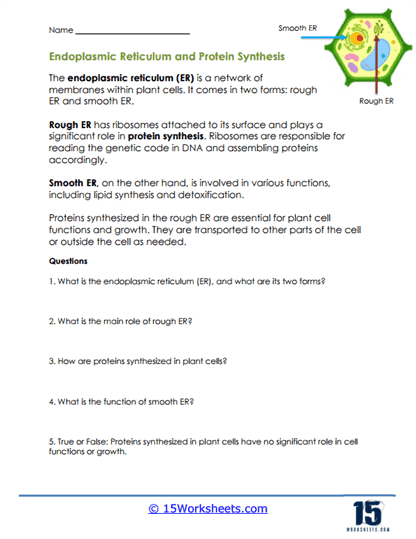Endoplasmic Reticulum and Protein Synthesis

Worksheet Description
This worksheet explores the intricacies of the endoplasmic reticulum (ER) and its crucial role in protein synthesis within plant cells. The ER, a complex network of membranes, manifests in two distinct forms: the rough ER, characterized by ribosomes on its surface, and the smooth ER. While the rough ER is integral to protein synthesis, reading the genetic code in DNA and assembling proteins, the smooth ER has multifaceted roles, including lipid synthesis and detoxification. Additionally, the sheet touches upon the transport of proteins synthesized in the ER to various parts of the cell or outside, contingent on the cell’s needs.
To adeptly address this worksheet, students should initiate their approach by carefully reading the provided details on the endoplasmic reticulum and its role in protein synthesis. Once familiarized with the foundational concepts, they can proceed to the questions, ensuring their answers align with the information given. For any uncertainties or for reinforcement, revisiting the main content is advisable, leveraging it as a reference. Through such a systematic methodology, students will not only offer precise answers but will also internalize the fundamental concepts presented.
The worksheet endeavors to impart a comprehensive understanding of the endoplasmic reticulum’s structure and function in plant cells. By diving into the distinctions between the rough and smooth ER, students are introduced to the nuanced roles each plays, from protein synthesis to lipid formation. Furthermore, the worksheet emphasizes the significance of proteins in cell growth and function, elucidating their synthesis in the ER and subsequent transport to where they are needed. In essence, this educational tool aims to provide students with a profound grasp of the endoplasmic reticulum’s role, fostering an appreciation for the complex cellular mechanisms that govern plant cell operations.
